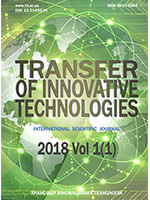Modeling the reliability of the recycled water supply system in the conditions of global warming
DOI:
https://doi.org/10.31493/tit1811.0201Keywords:
Balance, water consumption coefficient, reverse water, evaporation coefficient, artificial supply system, hardnessAbstract
The issues of re-used water for recreational purposes were studied. The organic system of the enterprise may be a recycled system of water supply, hermetically sealed and equipped with automatic sensors, in every sense. It is also appropriate to use the remote controlling for thermal engineering parameters at factory sections using GPS modules. The importance of the corporate accent lies in the creation of social responsibility for service-managers and mechanics for each resource saving actions and future economic preferences. The most perspective and socially motivated direction of recycling is the modeling of balance of different water flows, considering the quality of chemical components. Currently, citizens and the administration of technoparks evaluate the clean water for such indicators: - water safety (sanitary and epidemiological requirements); - availability of water (quantity and quality); - stability water quality (water for ecosystems, water for health, water for sustainable development); - climate change and water security. To conform these indicators, an experiments were undertaken for different work modes of enterprise equipment. So to determine the optimal amount of fresh water supply, the second order of central orthogonal compositional planning is used. Mathematic model was obtained during scientific experiment. The system modeling considering hardness of water supply (1,5…10,5 m-q/l), the water alkalinity (1,5…10 m-q/l) gives the predictive data on the permissible coefficient of circulating water evaporation. On the basis of this simulation, it is advisable to recommend the preparation of artificial recharge supply with water hardness of 1,5 m-q/l at the enterprises. It will allow the system to operate at evaporation coefficient of 2,55 and save fresh water volume, equal to the production cycle. So the using of agricultural waste (chitosan) shows the possibility of its using for local sewage water cleaning of industrial cycles. The same solution can be used to feed vegetable and ornamental crops, in the local agricultural landscape of the enterprise. Development of the subsidiary production, allows to expand the range of production and to improve the company´s image.References
Pantelyat G.S., 1982. Issledovanie, razrabotka i osvoenie kompleksov zamknutyh system oborotnogo vodosnabgenia osnovnyh proizvodstv metallurgicheskyx predpriztyu bez sbrosa stochnyh vod v vodoem. Zamknutye systemy vodnogo hozyaistva promyslennyx predpriztiy i rayonov. МDNTP, Мoskow, Znaniye, 33-39 (in Russian).
Тovazhnyanskiy L.L., Gotlinskaya А.P., 2005. Procesy y aparaty himichnoy technology. Procesy y aparaty himichnoy technologyi: [pidrucnik v 2-h chastinah. Harkiv, NTU HPY, 532 (in Russian).
Drozdova G.G., 2004. Metodika opredeleniya efectivnisti zatrat na ohranu prirody. Кyiv, КGTU, 12 (in Russian).
Nazarenko О.М., Кuzmenko А.А., 2017. Benchmarking dzerel zhivilnoy vody. Zbirnyk naukovich prats, Naukovy visnuk budivniztva Harkiv, HNUBA, 111-117 (in Ukrainian).
Hosocava, Tezyo, Ivasaki, 1999. Кurita rukovodstvo po vodopodgotovke. Water Industries LTD, 2d izdanie, 244 (in Russian).
Nazarenko O.M., 2018. Ryzyk management vodokorystuvachiv richky Dnipro. Monografia. Zaporozhye, 203 (in Ukrainian).
Semenov О.Е., 2011. Vvedenie v experimentalnuyu meteorologiyu i klimatologiy u peschanych byr. Almaty, 187 (in Russian).
Shypulin V.D., 2010. Osnovnye prinstipy geoinformatsionnyh system. Harkiv, HNAGH, 337 (in Russian).
Alekseev V.I., 2003. Proektirovanie sooruzheny pererabotki I utilizatii stochnych vod s ispolzovaniem elementov computernych informatsionnyh technologiy. Moskow, Izd-vo АSV, 176 (in Russian).
Basos N.Ju., 2010. Biocentrichesko-setevaja struktura urbanizacii landshaftov (na primere kontinental'nyh i primors'kih gorodov). Saarbrucken, Lambert-Academic Publishers, 92 (in Russian).
Patent UA №123556, MPK, F17D5/02/2006. 01. Sistema vіddalenogo monіtoringu parametrіv teplonosіja u dvotrubnih teplovih merezhah. Nazarenko O.M., Bіchenko K.O. No.U201710667, zajavl.02.11.2017, opubl. 26.02.18, Bjul.4 (in Ukrainian).
Horuzhij P.D., 2003. Resursosberegajuchі tehnologії vodopostachannja Kyiv, Agrarna nauka, 534 (in Ukrainian).
Pierchurski F., 2005. Straty wody I sposoby ich obnizahia Ochrona Srodowiska. Straty wody i sposoby ich obnizahia, Ochrona Srodowiska (in Poland).
Chejlitko A.A., 2014. Opredelenie kojefficienta teploprovodnosti poristyh metallicheskih izdelij. Nauchnyj vestnik, Tambov, OOO Konsaltingovaja kompanija Jukom, Vol.1, 111-118 (in Russian).
Goncharuk V.V., 2011. Perspektivy razvitija fundamental'nyh i prikladnyh issledovanij v oblasti fiziki, himii i biologii vod Kyiv, Naukova dumka, 407 (in Russian).
Korchemljuk M.V., 2016. Ekologіchnі naslіdki global'nih klіmatichnih zmіn/ M.V.Korchemljuk Ekologіchnі naslіdki global'nih klіmatichnih zmіn. Naukovij vіsnik ІFTUNG: naukovo-tehnіchnij zhurnal, No.1(13), 120-129 (in Ukrainian).
Martazinova V., 2002. Zminy v climati Ukrainy. Geographiya ta osnovy ekonomiky v shkoli, No.1(25), 31-33 (In Ukraininan).
Gavich I.K., 1980. Teoriya I praktika primeneniya modelirovaniya v gidrogeologii. Moskow, Nedra, 358 (in Russian).
Kuprienko P., Lapowska S., Kuprienko N, 2017. Nanomodified natural aluminum silicates in technology treatment of industrial waste and the production of building materials. Underwater Technologies, Iss.05, 74-83.
Nadutyi V., Chelyschkina V., Kostyrya S., 2016. Analysis of the integrated dewatering of fine fractions of granite. Underwater Technologies, Iss.03, 41-46 (in Russian).
Downloads
Published
How to Cite
Issue
Section
License
Copyright (c) 2020 Transfer of Innovative Technologies

This work is licensed under a Creative Commons Attribution-NonCommercial-NoDerivatives 4.0 International License.
Our journal abides by the CREATIVE COMMONS copyright rights and permissions for open access journals.
Authors, who are published in this journal, agree to the following conditions:
1. The authors reserve the right to authorship of the work and pass the first publication right of this work to the journal under the terms of a Creative Commons Attribution License, which allows others to freely distribute the published research with the obligatory reference to the authors of the original work and the first publication of the work in this journal.
2. The authors have the right to conclude separate supplement agreements that relate to non-exclusive work distribution in the form in which it has been published by the journal (for example, to upload the work to the online storage of the journal or publish it as part of a monograph), provided that the reference to the first publication of the work in this journal is included.




